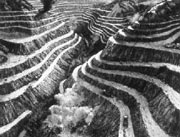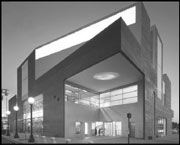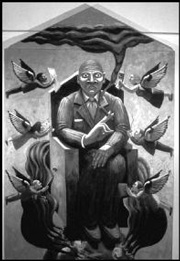SAM LIGHTS UP! 10TH ANNIVERSARY PARTY
Seattle Art Museum, 100 University, 654-3255, $3 adults, $2 seniors, students 5 p.m. Thurs., Dec. 6
TACOMA ART MUSEUM
1123 Pacific , Tacoma 253-272-4258, $5 10 a.m.-5 p.m., Tues.-Sat.; 10 a.m.-8 p.m. Thurs.; noon-5 p.m. Sun.
WHEN THE SEATTLE Art Museum opened the doors to its downtown location in December 1991, arts patrons effused a great deal of enthusiasm over the important works this new building would bring to the city. Finally we’d be able to make some deeper connections to art. Sure enough, SAM has staged a number of popular blockbusters-Impressionism, John Singer Sargent, and large archeological collections, to name just a few-but on this 10th anniversary of the museum’s grand opening, is it churlish to feel a certain disappointment? The current Annie Leibovitz exhibit of celebrity photographs and simplistically stated reversals of archetypes-an exhibit with all the depth of Vanity Fair-is a reminder of too many similar ones: easygoing and eager to please, with a lot of worrying about the happiness of guests. Where are the challenging thrills we expected a decade ago?
Actually, they’re 40 miles south. The Tacoma Art Museum, a neglected gem in a much-derided city, has for years been mounting carefully crafted shows that satisfy in the way of a good French meal-creative and memorable, with just the right amount served. Two years away from moving into a new space (an open and airy design by Antoine Predock), TAM is poised to become the region’s premier destination for art. It is a museum that consistently finds the fresh perspective, often presents provocative work, educates without condescending (unlike the tour guide at SAM whose questions to her adult group on Leibovitz’s work seemed intended for children), and has been dedicated to the support of regional artists, particularly through its open competitions.
In the past, TAM has exhibited Picasso’s little-seen ceramics, modern religious allegory, Alice Neel’s luridly frank portraits of family and friends, work from its Northwest Biennial, and an excellent survey (just closed) of African-American artists from the 1840s to today. In December, it offers three similarly excellent exhibits: elegant prints from a fine-arts press that provide a rare glimpse of artistic collaboration, a historically significant show called “Art for the Masses” that looks at a program begun in the 1930s by Associated American Artists to introduce “democratic” art to the public, and “Urban Invasion,” 16 paintings from the unsettling brush of Chester Arnold.
For Seattelites, one of TAM’s smart, sometimes edgy shows makes for an engaging day, but can sting like a reproof in that glancing way of pleasure discovered elsewhere: Why can’t we get the same kind of inventiveness here? Unlike TAM’s shows, SAM’s don’t seem so much crafted as they do scooped up and served on a big plate like a ladle of hearty stew—filling but too often unimaginative.
There are burdens, of course, on an art museum bearing the name of the city it serves. It must please a wide range of people, from residents to tourists to benefactors, and has a responsibility to represent the area’s cultural mix. But SAM tends toward a “never offend” stance—that damnable Northwest credo—putting a lid on risk and giving us the mild worlds of Chuck Close, Cindy Sherman, and Thomas Moran, and jumbled private collections with a something-for-everyone attraction. After a while, one craves the unexpected, a new look at a familiar master or culture, or, better yet, some focused risk taking with contemporary artists- something that occasionally jolts us out of that complacent museum stare. The Sargent exhibit, lovingly put together by Trevor Fairbrother, was a step in that direction, a show that didn’t simply reinforce our perceptions of an artist long associated only with flattering the upper crust. But, of course, it was Fairbrother’s last hurrah.
TAM’s curators, on the other hand, have a knack for finding surprises, for presenting art-through individual works, themes, history, or the process behind the creation-with a focus not found at SAM. The Beta Press exhibit (closing Dec. 31), for example, lets us see the trial proofs of prints by several prominent artists, including Fay Jones and Jacob Lawrence. A fascinating sequence of proofs for Lawrence’s Ten Builders etching, all covered with notes from both artist and printer, shows the attentiveness and precision of two masters working together. The prints, too, from Art for the Masses, with their quiet inward-looking scenes of ordinary people and places, reveal a socially conscious period of realism not often on display with such depth, one that illuminates an overlooked artistic side of a troubled time not unlike our own.
And TAM, unlike SAM, does not shy away from embracing that trouble, even in these oversensitive days when portraying the public’s unease is seen as an offensive act. In Chester Arnold’s meticulous paintings in “Urban Invasion” (opening Dec. 11), we become the all-too-familiar distant spectator of looming or erupting catastrophe. In Coliseum, a blimp’s view of a crowded sports stadium lets us witness some kind of chaos in progress (indistinct explosions and fires), and in The Onerous Developments of March 4, 1994, an idyllic country house teeters on the edge of oblivion. It is disquieting but invigorating work—a far cry from celebrity photos, but just down the highway and well worth the drive.








